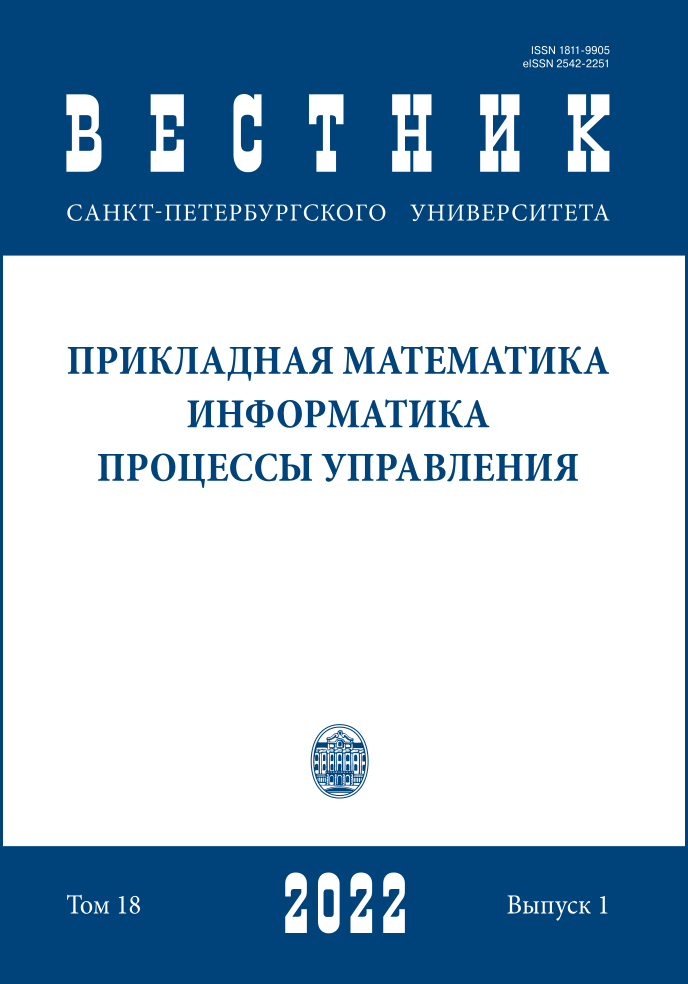Approximation of supremum and infimum processes as a stochastic approach to the providing of homeostasis
DOI:
https://doi.org/10.21638/11701/spbu10.2022.101Abstract
We consider the calculation of bounded functional of the trajectories of a stationary diffusion process. Since an analytical solution to this problem does not exist, it is necessary to use numerical methods. One possible direction for obtaining the numerical method is applying the Monte Carlo (MC) method. This involves reproducing the trajectory of a random process with subsequent averaging over the trajectories. To simplify the reproduction of the trajectory, the Girsanov transform is used in this paper. The main goal is to approximate the supremum and infimum processes, which allows us to more accurately compute the mathematical expectation of a function depending on the values of the supremum and infimum processes at the end of the time interval compared to the classical method. The method is based on randomly dividing the interval of the time axis by stopping times passages of the Wiener process, approximating the density to replace the measure, and using the MC method to calculate the expectation. One of the applications of the method is the task of keeping a random process in a given area — the problem of homeostasis.
Keywords:
diffusion, Monte-Carlo method, Girsanov transform, homeostasis
Downloads
References
Fishman G. Monte-Carlo: concepts, algorithms and applications. New York: Springer, 1995. 722 p.
Kudryavtsev O. Approximate Wiener — Hopf factorization and Monte-Carlo methods for Levy processes // Probability Theory and its Applications. 2019. Vol. 64(2). P. 186–208.
Girsanov I. On the transformation of a class of random processes using a completely continuous measure replacement // Probability Theory and its Applications. 1960. Vol. 5. P. 314–330.
Новиков А. Об одном тождестве для стохастических интегралов // Теория вероятностей и ее применения. 1972. № 4. С. 761–765.
Kloeden P., Platen E. Numerical solution of stochastic differential equations. New York: Springer, 1995. 632 p.
Carr P. Randomization and American put // Rev. Financ. Stud. 1996. N 11. P. 597–626.
Kuznetsov A., Kyprianou A. E., Pardo J. C., van Schaik K. A Wiener — Hopf Monte-Carlo simulation technique for L'{e}vy processes // Ann. Appl. Prob. 2011. N 21. P. 2171–2190.
Ferreiro-Castilla A., Kyprianou A. E., Scheichl R., Suryanarayana G. Multilevel Monte-Carlo simulation for L'{e}vy processes based on the Wiener — Hopf factorization // Stoch. Process. Appl. 2014. N 124. P. 985–1010.
Beliavsky G., Danilova N., Ougolnitsky G. Calculation of probability of the exit of a stochastic process from a band by Monte-Carlo method: A Wiener — Hopf factorization // Mathematics. 2019. N 7. P. 581–597.
Beliavsky G. I., Danilova N. V. The combined Monte-Carlo method to calculate the capital of the optimal portfolio in nonlinear models of financial indexes // Siberian Electronic Mathematical Reports. 2014. N 11. P. 1021–1034.
Aubin J.-P. Viability theory. New York, USA: Springer-Verlag, 1991. 342 p.
Ougolnitsky G. Sustainable management. New York, USA: Nova Science Publ. Hauppauge, 2011. 287 p.
Ширяев А. Н. О мартингальных методах в задачах о пересечении границ броуновским движением // Современные проблемы математики. 2007. Вып. 8. С. 3–78.
Casella G., Robert C. P., Wells M. T. Generalized accept-reject sampling chemes // Institute of Mathematical Statistics. 2004. P. 342–347.
Камачкин А. М., Степенко Н. А., Хитров Г. М. К теории конструктивного построения линейного регулятора // Вестник Санкт-Петербургского университета. Прикладная математика. Информатика. Процессы управления. 2020. Т. 16. Вып. 3. С. 326–344. https://doi.org/10.21638/11701/spbu10.2020.309
References
Fishman G. {it Monte-Carlo: concepts, algorithms and applications}. New York, Springer Publ., 1995, 722 p.
Kudryavtsev O. Approximate Wiener — Hopf factorization and Monte-Carlo methods for Levy processes. {it Probability Theory and its Applications}, 2019, vol. 64(2), pp. 186–208.
Girsanov I. On the transformation of a class of random processes using a completely continuous measure replacement. {it Probability Theory and its Applications}, 1960, vol. 5, pp. 314–330.
Novikov А. Ob odnom tozhdestve dlia stokhasticheskikh integralov [On one identity for stochastic integrals]. Teoriia veroiatnostei i ee primeneniia [Probability Theory and its Applications], 1972, no. 4, pp. 761–765. (In Russian)
Kloeden P., Platen E. Numerical solution of stochastic differential equations. New York, Springer Publ., 1995, 632 p.
Carr P. Randomization and American put. Rev. Financ. Stud., 1996, no. 11, pp. 597–626.
Kuznetsov A., Kyprianou A. E., Pardo J. C., van Schaik K. A Wiener — Hopf Monte-Carlo simulation technique for L'{e}vy processes. Ann. Appl. Prob., 2011, no. 21, pp. 2171–2190.
Ferreiro-Castilla A., Kyprianou A. E., Scheichl R., Suryanarayana G. Multilevel Monte-Carlo simulation for L'{e}vy processes based on the Wiener — Hopf factorization. Stoch. Process. Appl., 2014. no. 124, pp. 985–1010.
Beliavsky G., Danilova N., Ougolnitsky G. Calculation of probability of the exit of a stochastic process from a band by Monte-Carlo method: A Wiener — Hopf factorization. Mathematics, 2019, no. 7, pp. 581–597.
Beliavsky G. I., Danilova N. V. The combined Monte-Carlo method to calculate the capital of the optimal portfolio in nonlinear models of financial indexes. Siberian Electronic Mathematical Reports, 2014, no. 11, pp. 1021–1034.
Aubin J.-P. Viability theory. New York, USA, Springer-Verlag Publ., 1991, 342 p.
Ougolnitsky G. Sustainable management. New York, USA, Nova Science Publ., Hauppauge, 2011, 287 p.
Shiryaev А. N. O martingal'nykh metodakh v zadachakh o peresechenii granits brounovskim dvizheniem [On martingale methods in problems of boundary crossing by Brownian motion]. Sovremennye problemy matematiki [Modern mathematics problems], 2007, iss. 8, pp. 3–78. (In Russian)
Casella G., Robert C. P., Wells M. T. Generalized accept-reject sampling chemes. Institute of Mathematical Statistics, 2004, pp. 342–347.
Kamachkin А. М., Stepenko N. А., Chitrov G. М. K teorii konstruktivnogo postroeniia lineinogo reguliatora [On the theory of constructive construction of a linear regulator]. Vestnik of Saint Petersburg University. Applied Mathematics. Computer Sciences. Control Processes, 2020, vol. 16, iss. 3, pp. 326–344. https://doi.org/10.21638/11701/spbu10.2020.309 (In Russian)
Downloads
Published
How to Cite
Issue
Section
License
Articles of "Vestnik of Saint Petersburg University. Applied Mathematics. Computer Science. Control Processes" are open access distributed under the terms of the License Agreement with Saint Petersburg State University, which permits to the authors unrestricted distribution and self-archiving free of charge.





